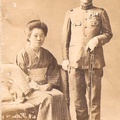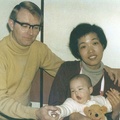Spark
Use room-temperature water, never ice. Skin holds heat,
you think you’re more burned than you are.
Your singed hair crimps and smells like eggs
that once cooked on the farmhouse’s old gas stove.
Bathwater runs faster than a sink’s, you kneel
to turn your face under the tub’s faucet.
If you’d followed directions, you’d be
in the pasture instead, palming sugar to the horses.
Which sent you reeling back, the oven’s flash
or pressure, the heat or fear? Obaasan fell forward
but that was different, that was a great wind, that was outside;
you’re in a house, your clothes are on, you’ve hurt only yourself.
Hard to remember the spark in first person, the tipping,
if the arms flew up or down. A spot on her cheek
continued to weep. You wanted to see the colors
of fall leaves, to pick apples in the hills.
Your sleeves are soaked at the wrists, you’re given oxygen.
The warmth of the skin is normal, your face is there, there
really is no mirror. Deep breaths. Think of stone stairs
you’d wanted to take to the river, the cold tin rush
of water, a wooden footbridge. The truck ceiling
is strange, metallic, you want to touch it--
what your dad must have seen. Could he feel his face?
What if there were no trucks? Who’d save you
wandering between a canal and sweet potato fields?
They say lilies bloomed in the ashes.
Distances
Like rippled rings in a lake,
extending out from
where a rock’s been thrown in,
concentric circles on a map
mark distances
from the epicenter—
there’s Koi Station, where
Obaasan was ordered off the train
with all of the volunteers
when the drill sounded.
“2.5 kilometers”the map says.
But,“Obaasan was about one ri away,”
my mother wrote in a letter
when I told her
what I was writing about.
“One ri is 3.9 kilometers.”
I did the math.
Had the train station moved?
No, the map’s dated 1945.
And she walked toward the city
carrying rope in her hand.
At 2.5 kilometers,
wood, clothing,
the color black scorched,
the air 50 times hotter
than sunlight
on a clear summer day.
All day people poured into Asano Park
drawn to the green coolness and shelter of leaves.
No one, not even children cried.
No one talked,
that is, very few people cried, or talked.
The figure on the ground was a woman.
Her baby unbuttoned her blouse and drank,
that is, her baby clutched at her
bare breast and drank.
When she rinsed her scarf in the river,
one seam came undone,
that is, the entire cloth
dissolved in her hands.
***
* Poems first published in The Asian American Literary Review, Issue 1. AALR is a not-for-profit literary arts journal, a showcase of the best of today’s Asian American literature. To learn more about the journal or purchase a subscription, visit them online at www.asianamericanliteraryreview.org, or find them on Facebook.
© 2010 April Naoko Heck






